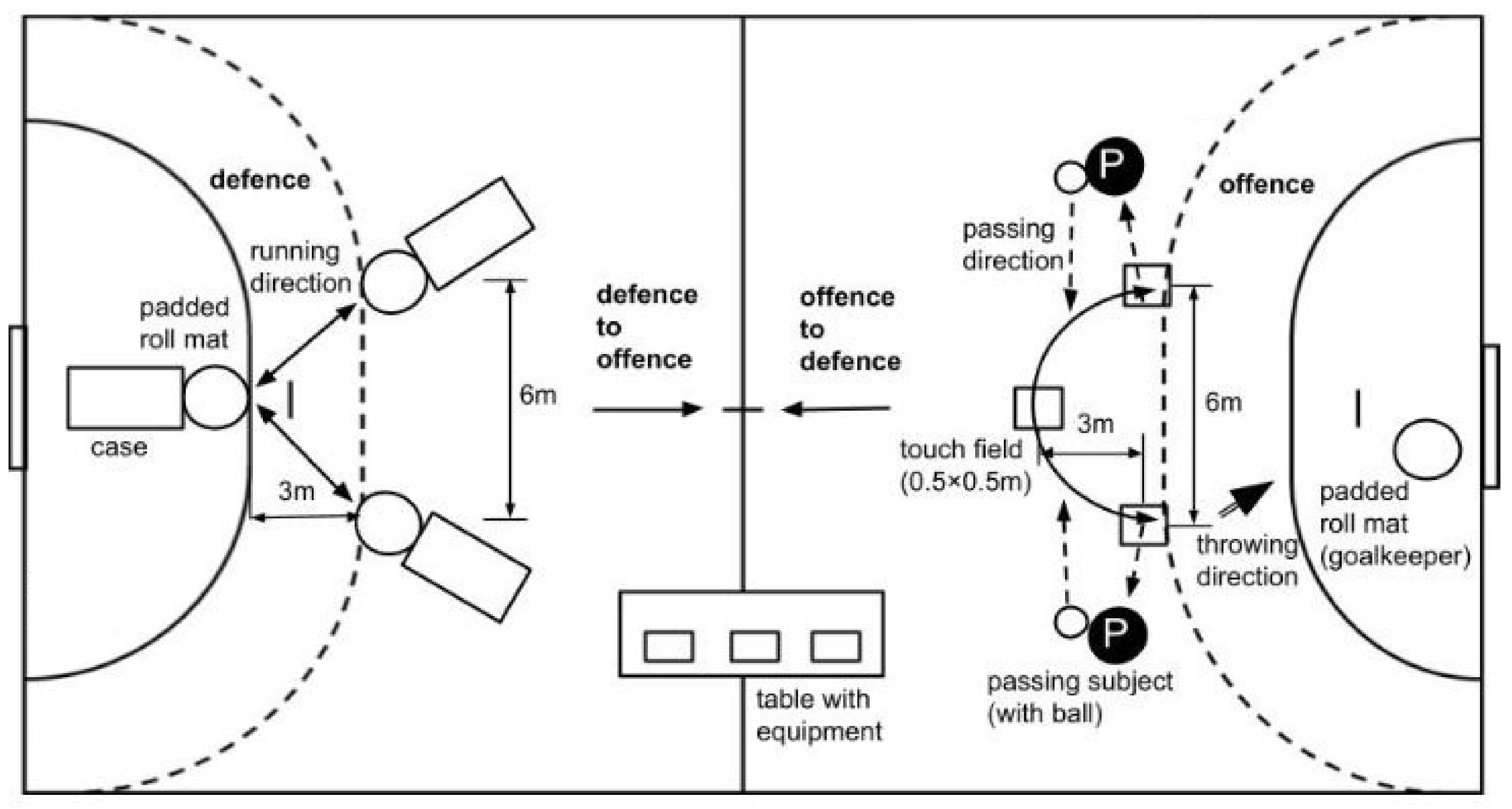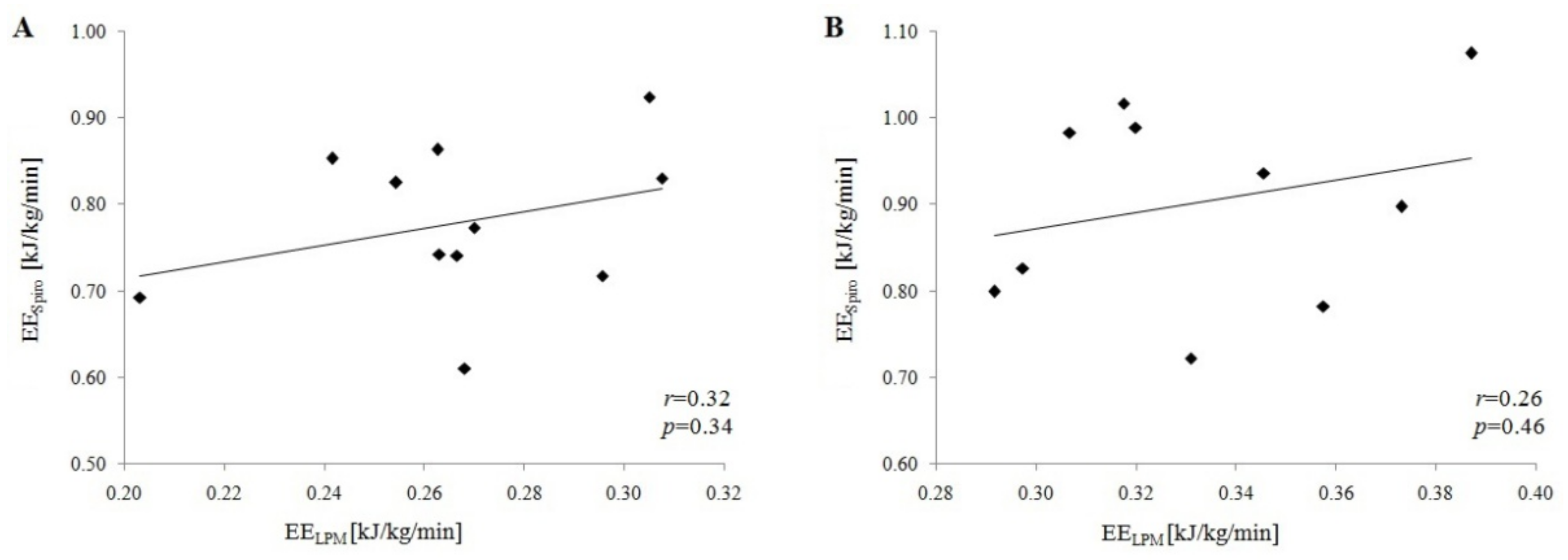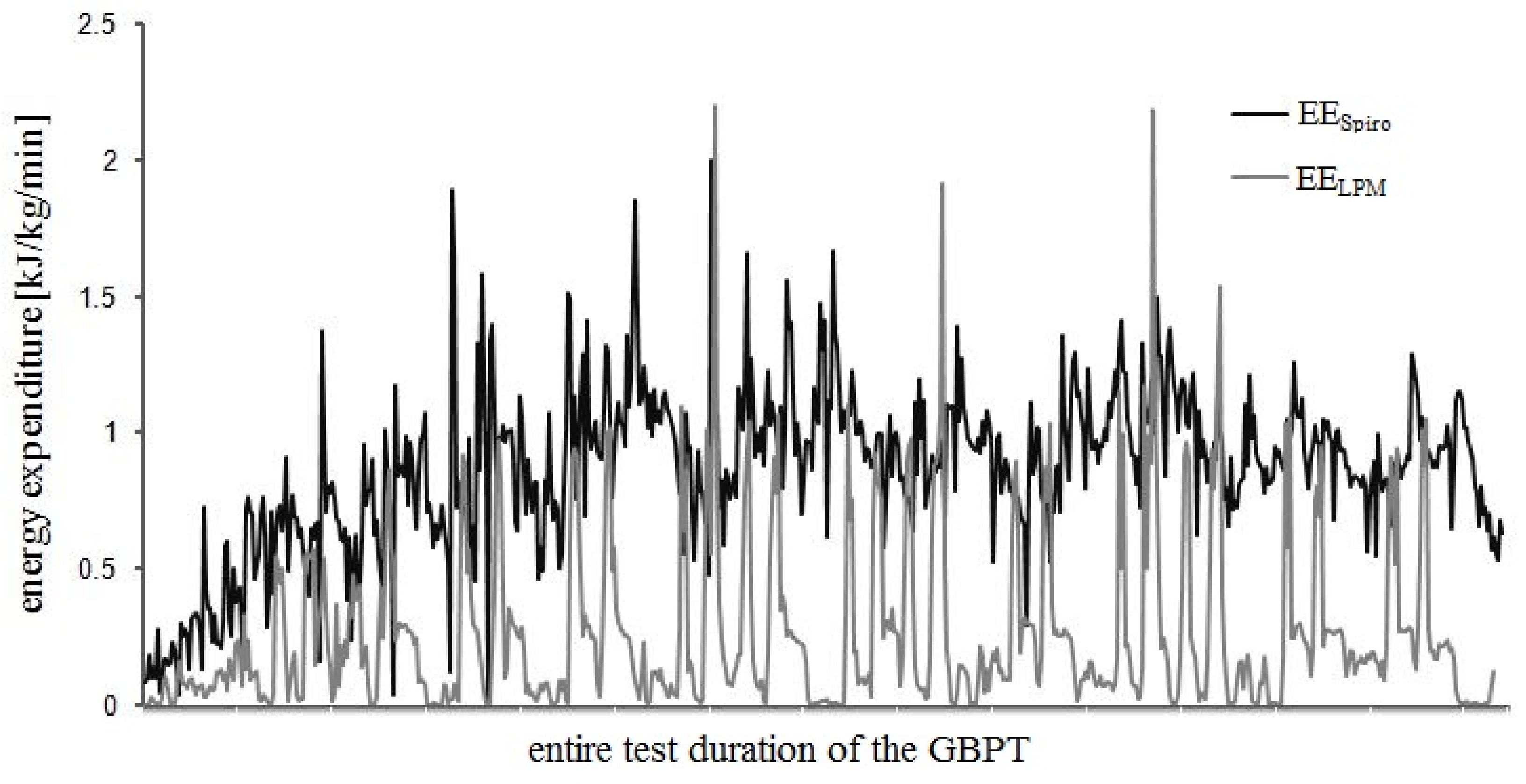Comparative Analysis of the Indirect Calorimetry and the Metabolic Power Method to Calculate Energy Expenditure in Team Handball
Abstract
:1. Introduction
2. Materials and Methods
2.1. Participants
2.2. Study Design
2.3. Game-Based Performance Test
2.4. Testing Methods
2.5. Statistical Analysis
3. Results
4. Discussion
5. Conclusions
Author Contributions
Funding
Institutional Review Board Statement
Informed Consent Statement
Data Availability Statement
Acknowledgments
Conflicts of Interest
References
- Oliva-Lozano, J.M.; Muyor, J.M.; Fortes, V.; McLaren, S.J. Decomposing the variability of match physical performance in professional soccer: Implications for monitoring individuals. Eur. J. Sport Sci. 2020, 21, 1588–1596. [Google Scholar] [CrossRef]
- Debien, P.; Mancini, M.; Coimbra, D.R.; De Freitas, D.G.; Miranda, R.; Filho, M.G.B. Monitoring Training Load, Recovery, and Performance of Brazilian Professional Volleyball Players during a Season. Int. J. Sports Physiol. Perform. 2018, 13, 1182–1189. [Google Scholar] [CrossRef] [PubMed]
- Wik, E.H.; Luteberget, L.S.; Spencer, M. Activity Profiles in International Women’s Team Handball Using PlayerLoad. Int. J. Sports Physiol. Perform. 2017, 12, 934–942. [Google Scholar] [CrossRef]
- Hoogkamer, W.; Kipp, S.; Frank, J.H.; Farina, E.M.; Luo, G.; Kram, R. A Comparison of the Energetic Cost of Running in Marathon Racing Shoes. Sports Med. 2018, 48, 1009–1019. [Google Scholar] [CrossRef] [PubMed] [Green Version]
- Mady, C.E.K.; Igarashi, T.L.; Albuquerque, C.; Santos-Silva, P.R.; Fernandes, T.L.; Hernandez, A.J. Exergy efficiency on incremental stationary bicycle test: A new indicator of exercise performance? J. Braz. Soc. Mech. Sci. Eng. 2019, 41, 566. [Google Scholar] [CrossRef]
- Polglaze, T.; Hoppe, M.W. Metabolic Power: A Step in the Right Direction for Team Sports. Int. J. Sports Physiol. Perform. 2019, 14, 407–411. [Google Scholar] [CrossRef]
- Piras, A.; Raffi, M.; Atmatzidis, C.; Merni, F.; Di Michele, R. The Energy Cost of Running with the Ball in Soccer. Int. J. Sports Med. 2017, 38, 877-822. [Google Scholar] [CrossRef] [PubMed]
- Stevens, T.G.A.; DE Ruiter, C.J.; VAN Maurik, D.; VAN Lierop, C.J.W.; Savelsbergh, G.J.P.; Beek, P.J. Measured and Estimated Energy Cost of Constant and Shuttle Running in Soccer Players. Med. Sci. Sports Exerc. 2015, 47, 1219–1224. [Google Scholar] [CrossRef]
- Di Prampero, P.E.; Fusi, S.; Sepulcri, L.; Morin, J.-B.; Belli, A.; Antonutto, G. Sprint running: A new energetic approach. J. Exp. Biol. 2005, 208, 2809–2816. [Google Scholar] [CrossRef] [Green Version]
- Minetti, A.E.; Moia, C.; Roi, G.S.; Susta, D.; Ferretti, G. Energy cost of walking and running at extreme uphill and downhill slopes. J. Appl. Physiol. 2002, 93, 1039–1046. [Google Scholar] [CrossRef] [Green Version]
- Brown, D.M.; Dwyer, D.B.; Robertson, S.J.; Gastin, P.B. Metabolic Power Method: Underestimation of Energy Expenditure in Field-Sport Movements Using a Global Positioning System Tracking System. Int. J. Sports Physiol. Perform. 2016, 11, 1067–1073. [Google Scholar] [CrossRef] [Green Version]
- Buchheit, M.; Manouvrier, C.; Cassirame, J.; Morin, J.-B. Monitoring Locomotor Load in Soccer: Is Metabolic Power, Powerful? Int. J. Sports Med. 2015, 36, 1149–1155. [Google Scholar] [CrossRef] [PubMed] [Green Version]
- Highton, J.; Mullen, T.; Norris, J.; Oxendale, C.; Twist, C. The Unsuitability of Energy Expenditure Derived From Microtechnology for Assessing Internal Load in Collision-Based Activities. Int. J. Sports Physiol. Perform. 2017, 12, 264–267. [Google Scholar] [CrossRef]
- Luteberget, L.S.; Spencer, M. High-Intensity Events in International Women’s Team Handball Matches. Int. J. Sports Physiol. Perform. 2017, 12, 56–61. [Google Scholar] [CrossRef]
- Michalsik, L.B.; Aagaard, P.; Madsen, K. Technical Activity Profile and Influence of Body Anthropometry on Playing Performance in Female Elite Team Handball. J. Strength Cond. Res. 2015, 29, 1126–1138. [Google Scholar] [CrossRef] [PubMed]
- Michalsik, L.B.; Madsen, K.; Aagaard, P. Match Performance and Physiological Capacity of Female Elite Team Handball Players. Int. J. Sports Med. 2013, 35, 595–607. [Google Scholar] [CrossRef]
- Michalsik, L.B.; Aagaard, P.; Madsen, K. Locomotion Characteristics and Match-Induced Impairments in Physical Performance in Male Elite Team Handball Players. Int. J. Sports Med. 2012, 34, 590–599. [Google Scholar] [CrossRef]
- Buchheit, M.; Lepretre, P.; Behaegel, A.; Millet, G.; Cuvelier, G.; Ahmaidi, S. Cardiorespiratory responses during running and sport-specific exercises in handball players. J. Sci. Med. Sport 2009, 12, 399–405. [Google Scholar] [CrossRef]
- Wagner, H.; Orwat, M.; Hinz, M.; Pfusterschmied, J.; Bacharach, D.W.; von Duvillard, S.P.; Müller, E. Testing Game-Based Performance in Team-Handball. J. Strength Cond. Res. 2016, 30, 2794–2801. [Google Scholar] [CrossRef] [PubMed]
- Buglione, A.; di Prampero, P.E. The energy cost of shuttle running. Eur. J. Appl. Physiol. 2013, 113, 1535–1543. [Google Scholar] [CrossRef]
- Buchheit, M.; Simpson, B.M. Player-Tracking Technology: Half-Full or Half-Empty Glass? Int. J. Sports Physiol. Perform. 2017, 12 (Suppl. S2), S2–S35. [Google Scholar] [CrossRef] [Green Version]
- Osgnach, C.; Paolini, E.; Roberti, V.; Vettor, M.; di Prampero, P.E. Metabolic Power and Oxygen Consumption in Team Sports: A Brief Response to Buchheit et al. Int. J. Sports Med. 2016, 37, 77–81. [Google Scholar] [CrossRef] [PubMed]
- Panissa, V.L.G.; Fukuda, D.H.; Staibano, V.; Marques, M.; Franchini, E. Magnitude and duration of excess of post-exercise oxygen consumption between high-intensity interval and moderate-intensity continuous exercise: A systematic review. Obes. Rev. 2020, 22, 13099. [Google Scholar] [CrossRef]
- Arney, B.E.; Foster, C.; Porcari, J. EPOC: Is it real? Does it matter? ACSM’s Health Fit. J. 2019, 23, 9–13. [Google Scholar] [CrossRef]
- Michalsik, L.B.; Madsen, K.; Aagaard, P. Physiological capacity and physical testing in male elite team handball. J. Sports Med. Phys. Fit. 2015, 55, 415–429. [Google Scholar]
- Michalsik, L.B.; Madsen, K.; Aagaard, P. Technical Match Characteristics and Influence of Body Anthropometry on Playing Performance in Male Elite Team Handball. J. Strength Cond. Res. 2015, 29, 416–428. [Google Scholar] [CrossRef]
- Michalsik, L.B.; Aagaard, P. Physical demands in elite team handball: Comparisons between male and female players. J. Sports Med. Phys. Fit. 2014, 55, 878–891. [Google Scholar]
- Wagner, H.; Fuchs, P.X.; Von Duvillard, S.P. Specific physiological and biomechanical performance in elite, sub-elite and in non-elite male team handball players. J. Sports Med. Phys. Fit. 2018, 58, 73–81. [Google Scholar] [CrossRef] [PubMed]
- Perez-Suarez, I.; Martin-Rincon, M.; Henríquez, J.J.G.; Fezzardi, C.; Perez-Regalado, S.; Galvan-Alvarez, V.; Juan-Habib, J.W.; Morales-Alamo, D.; Calbet, J.A.L. Accuracy and Precision of the COSMED K5 Portable Analyser. Front. Physiol. 2018, 9, 1764. [Google Scholar] [CrossRef]
- Guidetti, L.; Meucci, M.; Bolletta, F.; Emerenziani, G.P.; Gallotta, M.C.; Baldari, C. Validity, reliability and minimum detectable change of COSMED K5 portable gas exchange system in breath-by-breath mode. PLoS ONE 2018, 13, e0209925. [Google Scholar] [CrossRef] [Green Version]
- Brockway, J.M. Derivation of formulae used to calculate energy expenditure in man. Hum. Nutr. Clin. Nutr. 1987, 41, 463–471. [Google Scholar] [PubMed]
- Jeukendrup, A.; Gleeson, M. Sport Nutrition: An Introduction to Energy Production and Performance; Human Kinetics: Champaign, IL, USA, 2004. [Google Scholar]
- Serpiello, F.R.; Hopkins, W.G.; Barnes, S.; Tavrou, J.; Duthie, G.M.; Aughey, R.J.; Ball, K. Validity of an ultra-wideband local positioning system to measure locomotion in indoor sports. J. Sports Sci. 2018, 36, 1727–1733. [Google Scholar] [CrossRef] [Green Version]
- Luteberget, L.S.; Spencer, M.; Gilgien, M. Validity of the Catapult ClearSky T6 Local Positioning System for Team Sports Specific Drills, in Indoor Conditions. Front. Physiol. 2018, 9, 115. [Google Scholar] [CrossRef] [PubMed] [Green Version]
- Osgnach, C.; Poser, S.; Bernardini, R.; Rinaldo, R.; DI Prampero, P.E. Energy Cost and Metabolic Power in Elite Soccer: A new match analysis approach. Med. Sci. Sports Exerc. 2010, 42, 170–178. [Google Scholar] [CrossRef]
- Di Prampero, P.E.; Osgnach, C. Metabolic Power in Team Sports—Part 1: An Update. Int. J. Sports Med. 2018, 39, 581–587. [Google Scholar] [CrossRef] [PubMed]
- Cohen, J. Statistical Power Analysis for the Behavioral Sciences, 2nd ed.; Lawrence Erlbaum Associates: New York, NY, USA, 1988. [Google Scholar]
- Wagner, H.; Fuchs, P.; Fusco, A.; Fuchs, P.X.; Bell, J.W.; Von Duvillard, S.P. Physical Performance in Elite Male and Female Team-Handball Players. Int. J. Sports Physiol. Perform. 2019, 14, 60–67. [Google Scholar] [CrossRef] [PubMed]



| Participants | ||||||||||||
|---|---|---|---|---|---|---|---|---|---|---|---|---|
| P01 | P02 | P03 | P04 | P05 | P06 | P07 | P08 | P09 | P10 | P11 | ||
| EESpiro | ||||||||||||
| [kJ/kg/min] | 0.86 | 0.83 | 0.74 | 0.82 | 0.85 | 0.69 | 0.74 | 0.77 | 0.92 | 0.61 | 0.72 | |
| [kJ/min] | 60.18 | 60.30 | 52.28 | 64.93 | 65.59 | 55.89 | 51.72 | 54.01 | 63.32 | 59.72 | 64.00 | |
| [kcal/min] | 14.38 | 14.41 | 12.50 | 15.52 | 15.68 | 13.36 | 12.36 | 12.91 | 15.31 | 14.27 | 15.30 | |
| Resting EE | ||||||||||||
| [kJ/kg/min] | 0.06 | 0.06 | 0.06 | 0.05 | 0.05 | 0.05 | 0.06 | 0.06 | 0.06 | 0.04 | 0.05 | |
| Pre-activated, motionless, resting EE | ||||||||||||
| [kJ/kg/min] | 0.71 | 0.69 | 0.60 | 0.77 | 0.81 | 0.69 | 0.64 | 0.72 | 0.72 | 0.47 | 0.58 | |
| EESpiro subtracted by resting EE | ||||||||||||
| [kJ/kg/min] | 0.81 | 0.78 | 0.69 | 0.77 | 0.80 | 0.64 | 0.68 | 0.72 | 0.87 | 0.57 | 0.67 | |
| [kJ/min] | 56.18 | 56.30 | 48.28 | 60.93 | 61.59 | 51.89 | 47.72 | 50.01 | 59.32 | 55.72 | 60.00 | |
| [kcal/min] | 13.43 | 13.46 | 11.54 | 14.56 | 14.72 | 12.40 | 11.41 | 11.95 | 14.18 | 13.32 | 14.34 | |
| EELPM | ||||||||||||
| [kJ/kg/min] | 0.26 | 0.31 | 0.26 | 0.25 | 0.24 | 0.20 | 0.27 | 0.27 | 0.30 | 0.27 | 0.30 | |
| [kJ/min] | 18.30 | 22.32 | 18.51 | 20.01 | 18.58 | 16.39 | 18.60 | 18.87 | 20.89 | 26.21 | 26.36 | |
| [kcal/min] | 4.37 | 5.33 | 4.42 | 4.78 | 4.44 | 3.92 | 4.45 | 4.51 | 4.99 | 6.26 | 6.30 | |
| Entire Test | H1 | H2 | H3 | H4 | H5 | H6 | H7 | H8 | ||
|---|---|---|---|---|---|---|---|---|---|---|
| r | 0.32 | 0 | 0.26 | 0.33 | 0.44 | 0.15 | 0.26 | 0.16 | 0.25 | |
| p | 0.34 | 1 | 0.43 | 0.33 | 0.18 | 0.69 | 0.46 | 0.66 | 0.49 | |
| H1 | H2 | H3 | H4 | H5 | H6 | H7 | H8 | |
|---|---|---|---|---|---|---|---|---|
| EESpiro | 0.79 ± 0.09 | 0.89 ± 0.12 | 0.90 ± 0.12 | 0.89 ± 0.11 | 0.81 ± 0.11 | 0.90 ± 0.12 | 0.82 ± 0.11 | 0.80 ± 0.09 |
| EELPM | 0.25 ± 0.03 | 0.28 ± 0.03 | 0.33 ± 0.04 | 0.32 ± 0.05 | 0.28 ± 0.04 | 0.33 ± 0.03 | 0.28 ± 0.03 | 0.30 ± 0.05 |
Publisher’s Note: MDPI stays neutral with regard to jurisdictional claims in published maps and institutional affiliations. |
© 2021 by the authors. Licensee MDPI, Basel, Switzerland. This article is an open access article distributed under the terms and conditions of the Creative Commons Attribution (CC BY) license (https://creativecommons.org/licenses/by/4.0/).
Share and Cite
Fuchs, P.; Luteberget, L.S.; Fuchs, P.X.; Wagner, H. Comparative Analysis of the Indirect Calorimetry and the Metabolic Power Method to Calculate Energy Expenditure in Team Handball. Appl. Sci. 2022, 12, 163. https://doi.org/10.3390/app12010163
Fuchs P, Luteberget LS, Fuchs PX, Wagner H. Comparative Analysis of the Indirect Calorimetry and the Metabolic Power Method to Calculate Energy Expenditure in Team Handball. Applied Sciences. 2022; 12(1):163. https://doi.org/10.3390/app12010163
Chicago/Turabian StyleFuchs, Patrick, Live S. Luteberget, Philip X. Fuchs, and Herbert Wagner. 2022. "Comparative Analysis of the Indirect Calorimetry and the Metabolic Power Method to Calculate Energy Expenditure in Team Handball" Applied Sciences 12, no. 1: 163. https://doi.org/10.3390/app12010163
APA StyleFuchs, P., Luteberget, L. S., Fuchs, P. X., & Wagner, H. (2022). Comparative Analysis of the Indirect Calorimetry and the Metabolic Power Method to Calculate Energy Expenditure in Team Handball. Applied Sciences, 12(1), 163. https://doi.org/10.3390/app12010163








